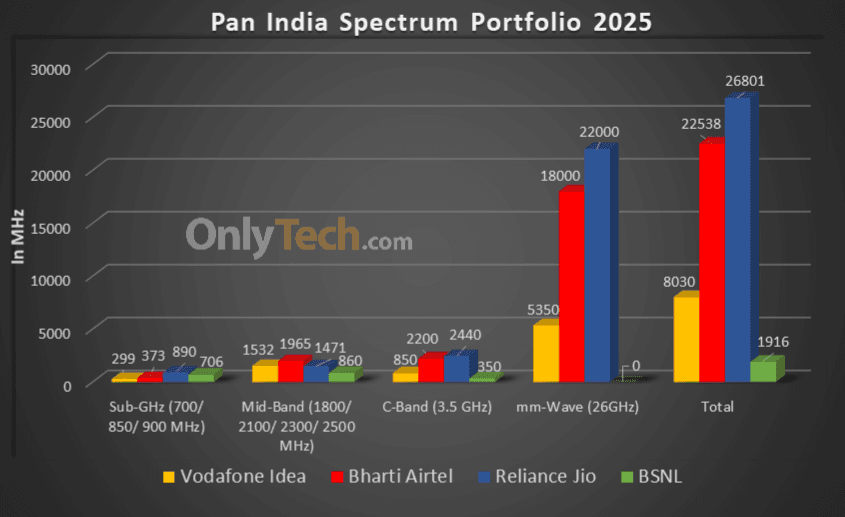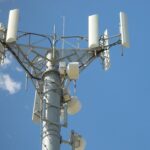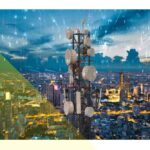Spectrum is for telecommunication what jet fuel is for aviation. Spectrum is a range of electromagnetic frequencies or airwaves that telecom companies use for establishing a connection between a cell tower and a mobile phone. The bandwidth of this spectrum is directly proportional to the speed of a wireless data network (since more data can be transmitted simultaneously through a broader data pipeline). In contrast, the frequency is inversely proportional to the coverage (since lower frequencies penetrate better through physical barriers and thus have wider coverage).
The spectrum holding data sheet embedded in this article represents the current spectrum holdings of all active telecom operators across all frequency bands across all 22 telecom circles along with their liberalisation status and expiry dates. All figures represented are in MHz. The value mentioned in the bracket beside the frequency at the base of each sheet is the band number where ‘B’ stands for 4G LTE band whereas ‘n’ stands for the corresponding 5G NR band.
The spectrum shown under BSNL and Aircel in white is reserved for the respective operators but has not yet been officially allotted to them.
Spectrum Liberalisation:
Spectrum was administratively allocated to operators in each of the 22 licensed service areas or circles prior to 2010, this spectrum is called non-liberalised and can only be used for 2G services whereas all airwaves allotted post-2010 have been through a Spectrum Auction where operators have paid the market discovered price and this spectrum is called liberalised and can be used for any technology platform 2G/3G/4G/5G. Alternatively, operators may choose to liberalise their administratively allotted spectrum by paying the market-discovered price to DoT on a pro-rata basis for the remaining validity of the spectrum.
Paired and Unpaired spectrum:
Spectrum may be paired or unpaired, bands 1/3/5/8/28 are all paired where one set of frequencies is used for uplink whereas another distinct set of frequencies is used for downlink known as Frequency-division duplexing (FDD), whereas bands 40/41/78/258 are unpaired where both uplink and downlink happens in the same set of frequencies separated by the time of uplink and downlink known as Time-division duplexing (TDD).
List of Indian FDD Bands:
| 4G LTE band | 5G NR band | Uplink frequency range (MHz) | Downlink frequency range (MHz) | Bandwidth for telecom (MHz) | Block size (MHz) |
|---|---|---|---|---|---|
| B1 | n1 | 1939-1979 | 2129-2169 | 40×2 | 5×2 |
| B3 | n3 | 1710-1780 | 1805-1875 | 70×2 | 0.2×2 |
| B5 | n5 | 824-844 | 869-889 | 20×2 | 1.25×2 |
| B8 | n8 | 890-915 | 935-960 | 25×2 | 0.2×2 |
| B28 | n28 | 723-733/ 738-748 | 778-788/ 793-803 | 20×2 | 5×2 |
List of Indian TDD Bands:
| 4G LTE band | 5G NR band | Frequency range (MHz) | Bandwidth for telecom (MHz) | Block size (MHz) |
|---|---|---|---|---|
| B40 | n40 | 2300-2380 | 80 | 10 |
| B41 | n41 | 2535-2555/ 2615-2655 | 60 | 10 |
| – | n78 | 3300-3670 | 370 | 10 |
| – | n258 | 24250-27500 | 3250 | 50 |
Spectrum caps:
A spectrum cap dictates how much spectrum a particular operator can hold in a circle for a specific band. There is a 40% cap for Sub-GHz spectrum in the 700/850/900 MHz bands combined, a 40% cap for Mid-Band spectrum in the 1800/2100/2300/2500 MHz bands combined, a 40% cap for the C-Band spectrum of 3300-3670 MHz and a 40% cap for the mm-Wave spectrum bands of 24.25-27.5 GHz. The current spectrum caps are denoted in the spectrum chart.
Overall spectrum holdings of operators (in MHz):
| Operator/Holding | Jio | Airtel | Vi | BSNL |
|---|---|---|---|---|
| Sub-GHz | 890 | 373.2 | 298.8 | 706 |
| Mid Band | 1470.8 | 1964.9 | 1531.6 | 860 |
| C-Band | 2440 | 2200 | 850 | 350 |
| mm-Wave Band | 22000 | 18000 | 5350 | 0 |
| Total | 26,800.8 | 22,538.1 | 8,030.4 | 1,916 |
Spectrum sharing/trading/leasing guidelines:
- Telecom operators holding CMTS/UASL/UL licenses can enter into a Spectrum-Sharing agreement with each other so long as both parties hold liberalised spectrum in the same band in the same circle. Spectrum sharing is possible only on a Pan LSA level in block sizes defined by DoT and only after one year of an operator acquiring the spectrum.
- Telecom operators holding CMTS/UASL/UL licenses can enter into a Spectrum-Trading agreement with each other so long as the spectrum being sold is liberalised. Trading of spectrum is possible only on a Pan LSA level in block sizes defined by DoT and only after two years of an operator acquiring the spectrum.
- Telecom operators may enter into a Spectrum-Leasing agreement only with Enterprises holding a Captive Non-Public Network (CNPN) license and not with each other. The lease may be limited to any geographic area within the LSA and for any duration mutually agreed upon by both parties. A CNPN licensee can lease spectrum from multiple operators within an LSA.
Note: We update this chart in real-time to ensure it is always up to date with the latest changes in spectrum holding. Certain human errors might have crept in during the manual compilation of the data, any mistakes/ rectification can be brought to the Team’s notice through the comments section below.








@esmail in which band adani group is likely to bid for ? Won’t it effect the 5G services for end users since spectrum availablity for telcos reduce ?
If Airtel, Jio and Adani all bid for 100 MHz in n78 and 500 MHz in n258 there will still be sufficient spectrum available for each of them. Vi is unlikely to bid meaningfully for 5G spectrum given its financials.
And about availability for future auctions, DoT has reserved some 5G spectrum for tech companies to buy directly from DoT, but if this doesn’t see much demand then DoT will most likely put that up for auction in the subsequent years, thus augmenting overall capacity.
You mean to say that there is more spectrum can be available in 3.3-3.7Ghz in future apart from 330Mhz?
Because Verizon alone has 200Mhz in C band(3.45+3.7Ghz) Atleast later this year(Is this possible in India, considering population of India 100Mhz of 3.5Ghz is not sufficient). Later this month, TMobile might have 190-210Mhz in each circle. Is it OK not to have any CBand stuff?
any band that can be released between 1000Mhz-2000Mhz in future with a bandwidth of 100-200Mhz?
Get your facts straight.
Verizon did not even participate in 3.45 GHz auction. It only has C-band spectrum in 3.7 GHz. But it can deploy most of the spectrum in 2024. It has only deployed 60 Mhz in 3.7 GHz n77.
T-Mobile has C-band spectrum of 40-60 MHz either in 3.45 GHz or 3.7 GHz for additional capacity. It’s anchor 5G band is n41, on which it deployed 20-100 Mhz for now. Nowhere it owns 190-210 MHz spectrum.
3.45+3.7(40Mhz+40Mhz+40Mhz) on Verizon giving 800Mbps early morning. Stop being critcizer everytime.
First of all, the word is “critic”.
Secondly, Verizon has nowhere deployed a third carrier of C-band.
Thirdly, Verizon has deployed/in the process of deploying 60 MHz of 3.7GHz spectrum nationwide.
Fourthly, deployment of DOD spectrum is being deployed slowly, first in high-demand PEAs (partial economic areas).
Fifthly, Verizon has announced that it would deploy 5G on n48 (CBRS) band, where it has 20-60 MHz of PALs (priority access licenses) and GAAs (general authorised accesses).
What you may have seen is probably a video of a speed test in a controlled environment, not on commercial spectrum. Besides, Verizon has, in several markets or PEAs, has clocked over 800 Mbps just on 60 MHz of 3.7 GHz spectrum (5G NSA).
Both AT&T and Verizon has deployed 3.45+3.7Ghz CA on Nokia site. I cannot attach photo sent by my cousin.
3.45 GHz sites are not active yet. They will be in sometime. AT&T started to install the radios in most major cities. Check out Sneed Mobile Tech and The Techxtremist’s YouTube channels.
Besides, you were talking about Verizon and T-Mobile, not AT&T.
The other thing is nowhere in the free world there is a live 3CA deployment on a 5G network. T-Mobile may launch it by the 2022-end, they’re only testing this capability.
Both AT&T and Verizon deployed 3.45+3.7 CA(40+60) in some markets. Samsung has disabled the service mode after June update on all their phones(I mean to say band locking). My cousin has S21 FE and S22 Plus. Both supports 3.45+3.7. That’s why can’t share it with you.
I have gone through channels you mention and it’s there in that as well. Check out once again.
Verizon did not even participate in 3.45 GHz auction. I say this again: get your facts straight. And watch the videos on the channels more carefully.
Check this: www (dot) dgtlinfra (dot) com/3-45-ghz-auction-110-results/
They have tested in trails. 100Mhz+90Mhz on n41 and 20Mhz in 2600Mhz(I don’t know which band exactly). 3CA gave 3Gbps. Google for yourself. There is auction coming up for n41 and it has 20Mhz-50Mhz to sale in n41. It will be great if TMobile acquires all of that.
US does not have 2600 MHz band (n7 or n38) because they have n41. Same is the case with India.
T-Mobile used one component of 100 MHz in n41 (commercially available), one component of 90 Mhz in n41 (trial spectrum) and one component of 10 MHz in n2 (commercially available), totalling 210 MHz since n2 is a FDD band. They were simply testing a nascent technology on a controlled environment.
In none of the PEAs in the US, T-Mobile owns or is able to use full 190 Mhz of spectrum in n41.
There is 160Mhz in n41 one of the PEAs(and there is 50Mhz being put into auction in this month, so its 210Mhz). It’s being put to use as CA. 100Mhz+60Mhz. For sure. Speeds above 500Mbps and 75Mbps. Check out once again.
The other thing is nowhere in the free world there is a live 3CA deployment on a 5G network. The first two bands were 5G and third block was 4G LTE on 2600Mhz(band 48 I guess, not sure).
n48 is CBRS, which is a subset of n77.
One block of n41 can accommodate upto 100 MHz of spectrum. There was no 4G LTE involved.
Check this: uk (dot) pcmag (dot) com/old-wireless-carriers/140925/t-mobile-hits-a-new-level-of-5g
Get your facts straight, man. At least google before you post a reply.
The reason is simple, said Karri Kuoppamaki, SVP, Technology Development & Strategy at T-Mobile. 5G as it’s defined sets the maximum carrier bandwidth at 100 MHz, and T-Mobile has more than 100 MHz of 2.5 GHz spectrum in major markets across the country. That’s why the 2.5 GHz 5G carrier aggregation is important – so that it can maximize its spectrum position and use it to the fullest extent possible on 5G.
Put another way: In any given market, T-Mobile has 160+ MHz of 2.5 GHz spectrum at its disposal. The way to use all of that is to take two 2.5 GHz carriers and aggregate them together, so they can fully use its 2.5 GHz spectrum for 5G.
Devices are starting to get upgrades this month, so certain handsets are already capable but they need to push out software updates to the devices so they’ll be able to use it by the end of the year. Not all devices will be capable at first, but over time, more of them will be able to take advantage of this 5G aggregation.
Both the iPhone 13 from Apple and most recent Android Samsung devices are capable of 2.5 GHz 5G carrier aggregation and the feature will be enabled via a software update, according to a T-Mobile spokesperson.
Bro, Keep your ego and knowledge with you. This is from the article in November 2021. So don’t teach me. This is 160Mhz on n41. And 50Mhz in same area will be auctioned later this month in auction 108. Go check the pdf of FCC. 160+50Mhz becomes 210Mhz. They have already tested 210Mhz(190Mhz+20Mhz)+20Mhz in another band(I don’t know last band is on 4G or 5G) 3CA to achieve 3Gbps speeds. Close to 2.9Gbps. Also on that 160Mhz n41 gives 500-1.3Gbps early morning free site(In real life on S22 Ultra/OP10Pro/Google Pixel 6 Pro).
Use your Internet resource properly. I hope you will Google the person named in above information.
The above comment is the conclusive proof that you don’t understand spectrum bands and by extension, telecom. There is NO 50 MHz carrier.
Also in n41, there is 196 Mhz of which 190 Mhz is usable.
Refer to the link I shared earlier.
“Simply stated, 5G Carrier Aggregation (NR CA) allows T-Mobile to combine multiple 5G channels (or carriers) to deliver greater speed and performance. In this test, the Un-carrier merged three 5G channels – two channels of 2.5 GHz Ultra Capacity 5G and one channel of 1900 MHz spectrum – creating an effective 210 MHz 5G channel. That’s all mid-band spectrum, by the way. And over 3 Gbps of speed!”
The above excerpt is from a T-Mobile press release from June 2022, not November 2021.
Link: www (dot) t-mobile (dot) com/news/network/t-mobile-tops-3-gbps-with-worlds-first-standalone-5g-carrier-aggregation-achievement
I only wish your brain was as big as your ego.
It’s from November 2021 only. Whether you trust me or not, it’s different thing. I talked about 160Mhz. Not 210Mhz. The 210Mhz test is recent one. I am not talking about that. I am just talking about n41 which is 160Mhz and there is auction this month. In which 48.5Mhz in same market is available to sell. I personally checked it on excel sheet of FCC documents. In some markets its 18.2Mhz and in some markets its 20.4Mhz. So 160Mhz+48.5Mhz comes out to be 210Mhz.
I don’t have any ego. Whatever I have been knowing I have shared. Verizon upgrading now to 100Mhz Cband quiet fast.
For the last time, the frequency range for n41 is 2496 MHz to 2690 MHz. That’s 194 Mhz. And it is the maximum capacity of the band. If an operator already has 160 Mhz in n41 it can buy a maximum of 34 Mhz, and not a Hz more because there will be nothing left in that band.
And yes, Verizon is actively upgrading it C-band sites to 100 Mhz because of an agreement with satellite companies. There was no 3.45 GHz spectrum involved.
FCC is going to auction unused spectrum in n41 shortly, and T-Mobile is seen as a frontrunner. But AT&T, US Cellular and Dish are also going to bid aggressively.
Yes n78 ranges from 3300-3800 MHz and in the future DoT may put up more spectrum in this range for auction as and when it gets released by other ministries like defence and department of space. n77 covers all the way up to 4200 MHz though most commercially sold 5G devices only support n78 so the range from 3800-4200 can be reserved for captive 5G network deployment for enterprise segment.
As for the 1GHz-2GHz range we may see the 1500MHz bands like B11 and B21 becoming available which are currently deployed in Japan which is also an ITU 3 country like India. But can’t say for sure.
Of 370 Mhz 40 Mhz is already reserved for BSNL. Jio will most probably get 100mhz. If Mittal and adani does same. Vodafone will have just 30Mhz. Will 30Mhz be sufficient ? Can’t DoT make private enterprise to just bid only in mmwaves.
Adani will not go for 100 MHz pan India in n78 looking at their EMD of just 100 CR. There will be sufficient spectrum for all 3 telcos to pick up airwaves tough I expect Vi to only selectively pick it up in some of their priority circles not on a pan India scale.
Will you able to update the spectrum chart today?
Na, you will have to wait for the final results to be declared. The auction isn’t over yet. Hopefully, it will end tomorrow. After that by day after the chart should be updated.
Thank you.
@esmail n78 is 3300Mhz or 3500Mhz band ? Can operators use say 110Mhz as one block for 5G or they need to use 100Mhz as a block ?
It’s called 3.5 GHz band globally, DoT likes to call or 3300 MHz band. Max block size is 100 MHz so it would have to be deployed accordingly.